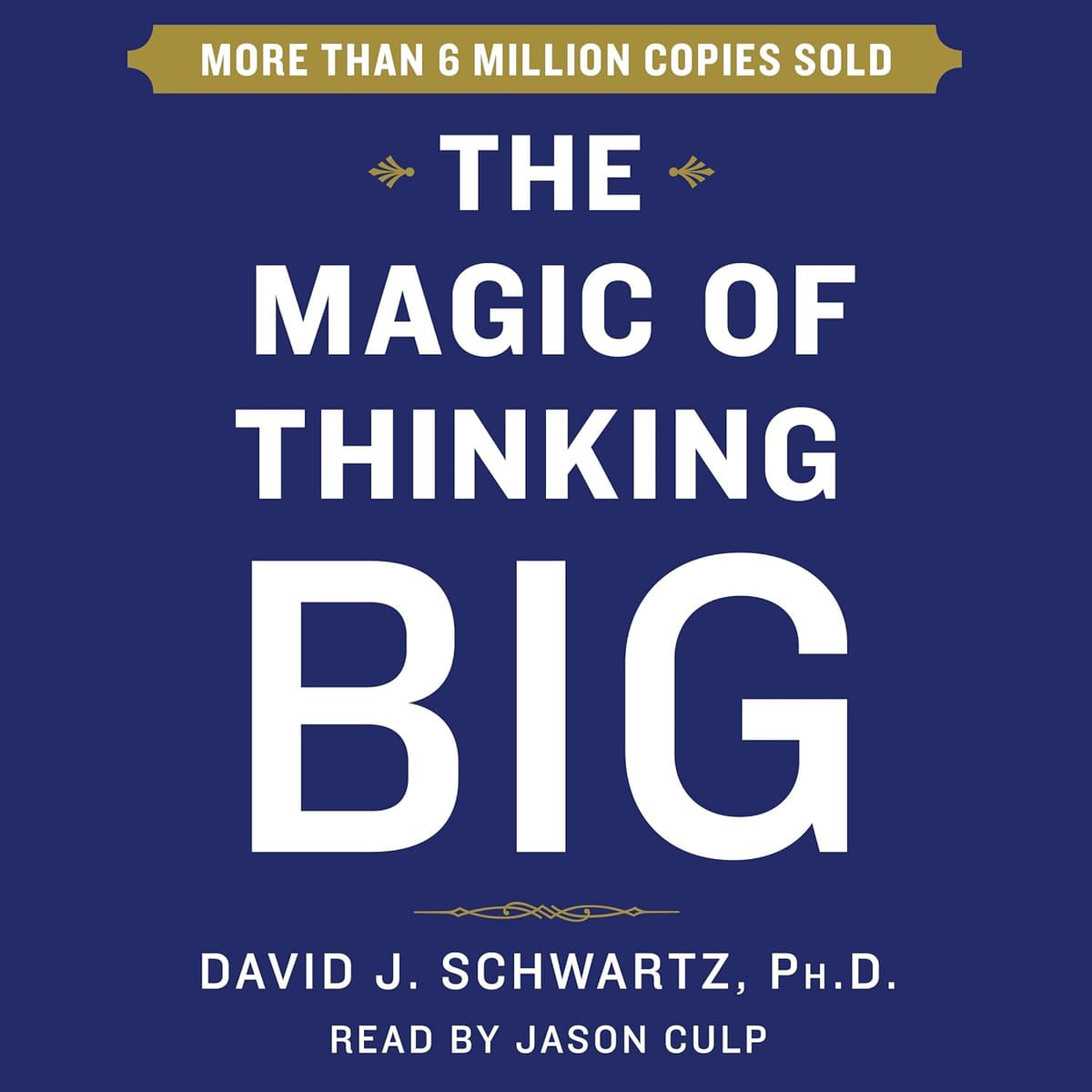Book Summary: The Magic of Thinking Big
Discover the key insights from "The Magic of Thinking Big" by David J. Schwartz in this comprehensive book summary article. Unlock your potential today!

Essential Insights
- Believing in oneself and having a positive mindset are crucial for achieving success.
- Setting big goals and taking action towards them is essential for personal growth.
- Developing confidence and overcoming fear of failure are key components of thinking big.
Introduction to The Magic of Thinking Big
The Magic of Thinking Big by David J. Schwartz is a timeless classic in the realm of personal development and leadership literature. Originally published in 1959, this book continues to resonate with readers seeking to unlock their full potential and achieve success in both their personal and professional lives. Dr. Schwartz, a renowned motivational writer and speaker, imparts valuable insights and strategies for thinking positively, setting ambitious goals, and overcoming self-imposed limitations.
For individuals aspiring to enhance their leadership skills and personal growth, The Magic of Thinking Big offers practical wisdom and actionable advice. By exploring the power of mindset and the impact of our thoughts on our actions, Schwartz guides readers towards a more confident and proactive approach to achieving their goals. Through real-life examples and engaging anecdotes, this book equips readers with the tools to cultivate a winning attitude, develop resilience in the face of challenges, and ultimately, lead a more fulfilling and successful life. Whether you're a seasoned leader looking to refine your skills or an aspiring professional eager to make meaningful strides, the principles outlined in this book have the potential to inspire and empower you on your journey to greatness.
Summary of The Magic of Thinking Big
The Magic of Thinking Big emphasizes the importance of mindset in achieving success and fulfillment in life. David J. Schwartz argues that thinking positively and ambitiously can yield extraordinary results. By nurturing big ideas and an optimistic outlook, individuals can overcome obstacles and reach their full potential. The book outlines practical strategies for developing confidence, overcoming fear, and setting high goals, making a strong case that one’s thinking directly impacts achievements.
One of the standout contributions of the book is its focus on the power of belief in oneself. Schwartz posits that self-belief acts as a catalyst for action and growth. Unlike many personal development works that emphasize sheer hard work or talent, Schwartz illustrates how cultivating a mindset that embraces possibility can change the trajectory of one’s life. He provides relatable examples and actionable steps for readers, turning concepts into practical applications. This blend of encouragement with practical advice sets The Magic of Thinking Big apart from its peers in the field. Notable ideas such as “action cures fear” and the importance of associating with positive influences outline practical strategies for readers eager to implement change.
Schwartz’s assertion that “you are what you think you are” serves as a foundation for personal growth, encouraging readers to reflect on their self-perception. As the discussion unfolds in this article, we will explore how the principles in the book can be applied to leadership and personal development, inspiring a journey of continuous improvement and empowerment.
Key Lessons From The Magic of Thinking Big
Think Creatively to Solve Problems
One of the central lessons in The Magic of Thinking Big is the power of creative thinking in addressing challenges. David J. Schwartz emphasizes that ordinary thinking leads to ordinary results, while cultivating a creative mindset opens doors to innovative solutions. Schwartz encourages readers to expand their thought processes and to visualize what is possible rather than what is constrained by current circumstances.
An example from the book illustrates this concept distinctly: Schwartz shares stories of individuals who faced daunting obstacles yet overcame them by refusing to see limits. One such story recounts how a failing business found success not by adhering to traditional methods, but by brainstorming new ideas and changes that ultimately revitalized the company. This exemplifies how thinking outside the box can directly contribute to tangible results.
The significance of this lesson lies in its straightforward yet profound message: creativity is not just reserved for artists; it is essential in every aspect of life. By challenging readers to consider unconventional alternatives, Schwartz inspires a shift in mindset that can lead to significant personal and professional breakthroughs. Embracing creative thought can transform challenges into stepping stones for success.
Set Clear Goals
He shares the story of a young man who aspired to climb the corporate ladder. By outlining specific steps toward his promotion and persistently pursuing those goals, he demonstrated how clarity in planning directly correlates to achievement. Schwartz emphasizes that visualizing these goals and writing them down can significantly enhance focus and determination.
This lesson challenges readers to evaluate their aspirations critically. Establishing concrete goals creates accountability and fosters persistence, key elements that can lead to substantial growth in both career and personal endeavors. By breaking down large ambitions into smaller, actionable steps, individuals can navigate their paths with confidence and clarity.
Maintain a Positive Attitude
A vital lesson from Schwartz’s work is the influence of a positive attitude on success. He argues that a constructive mindset not only attracts opportunities but also empowers individuals to overcome adversity. Schwartz believes that how one perceives challenges can drastically alter the outcome, stressing that positivity is a choice that plays a fundamental role in achieving one’s goals.
In one vivid example, Schwartz presents a scenario in which a team faces a seemingly insurmountable project. Rather than succumbing to negativity, the team adopts a positive approach, encouraging one another and focusing on potential solutions. This shift in mentality catalyzes a collective effort that leads them to ultimately complete the project successfully. The case illustrates that positivity can transform challenges into collaborative victories.
This lesson serves as a reminder of the power of optimism. By making the conscious choice to maintain a positive outlook, readers can foster resilience, enhance teamwork, and encourage a supportive environment. This mindset not only leads to improved performance but can create a more fulfilling life, where challenges are seen as opportunities for growth rather than insurmountable barriers.
Take Action Without Procrastination
Schwartz vividly illustrates the dangers of procrastination and the importance of taking immediate action towards goals. He argues that individuals often overthink or hesitate out of fear, which stunts their potential for growth. The book emphasizes that taking decisive action—no matter how small—can lead to significant progress and build momentum over time.
A compelling example from The Magic of Thinking Big recounts a college student who dreams of starting a business but delays taking any steps forward. After recognizing that his hesitation stems from fear of failure, he commits to taking at least one action each day, whether researching, networking, or creating a plan. This daily commitment leads to a successful business launch, demonstrating the importance of consistent action over perfection.
Encouraging readers to avoid delay challenges them to combat their fears and self-doubt. Immediate action fosters a sense of accomplishment, creating a positive feedback loop that fuels further motivation. By embracing this lesson, individuals can kick-start their aspirations, transforming ideas into reality and facilitating their personal and professional growth.
Application Ideas for The Magic of Thinking Big
Cultivate a Positive Mindset
The first step towards applying the lessons from The Magic of Thinking Big is to cultivate a positive mindset. Schwartz emphasizes that the way you think greatly influences your ability to achieve success. To implement this in daily life, start by consciously replacing negative thoughts with positive affirmations. Each day, take a few moments to jot down affirmations that resonate with your goals and aspirations, reaffirming your capacity to succeed.
Another effective application of this principle is to practice gratitude. Consider starting a gratitude journal where you list three things you are grateful for each day. This practice can shift your focus from obstacles to opportunities, empowering you to approach challenges with a more optimistic attitude. Over time, you will notice that your overall outlook will improve, leading to better decision-making and increased motivation.
To make the implementation easier, set a specific time each day for your affirmations and gratitude journaling, such as first thing in the morning or right before bed. Consistency is key; by developing a routine, these practices will become a natural part of your life. Finally, consider sharing your aspirations with a trusted friend or mentor. This accountability can boost your commitment, ensuring you stay positive and focused on your goals. For example, a manager who maintains a positive mindset while encouraging their team to do the same can foster an environment that promotes collaboration and innovation, leading to improved team dynamics and enhanced performance.
Set Clear, Achievable Goals
Another significant lesson from Schwartz is the importance of setting clear, achievable goals. The act of defining what you want to achieve allows you to create a roadmap for your future. Start by breaking down your larger goals into smaller, manageable tasks. Write these tasks down and set deadlines to create a sense of urgency and accountability. This structured approach can help you avoid feeling overwhelmed and make progress more tangible.
Implementing this concept can also involve using visualization techniques. Take a few minutes each day to visualize yourself accomplishing your goals. Imagine the steps you will take and the feelings you will experience upon reaching them. This practice reinforces your determination and keeps your objectives at the forefront of your mind, motivating you to take action consistently.
To facilitate the goal-setting process, consider using SMART criteria—Specific, Measurable, Achievable, Relevant, and Time-bound. This method not only ensures clarity but also allows you to track your progress effectively. As an example, a project manager might set a specific goal to complete a major project by a deadline while breaking it down into weekly tasks that can be monitored for progress. By continuously revisiting these goals, the manager can maintain a focused and disciplined approach, ultimately leading to project success.
Take Action and Embrace Risks
Schwartz strongly advocates for taking decisive actions to realize your ambitions, emphasizing that without action, dreams remain unrealized. Begin by identifying one action that brings you closer to your goals each day, no matter how small it may seem. This practice of taking consistent, gradual steps not only builds momentum but also helps you develop confidence in your abilities.
Additionally, embracing calculated risks can help you grow. Identify areas in your life where you have been playing it safe and consider what taking a small, manageable risk could look like. This might involve applying for a promotion, starting a side project, or approaching someone to collaborate. Growth often occurs outside your comfort zone, and engaging in these risks can lead to significant opportunities for development.
To ease the process, focus on the potential benefits of taking action rather than the fear of failure. Creating a supportive community around you can also encourage risk-taking; discussing ideas with like-minded individuals can inspire you to step out of your comfort zone. For example, a sales associate who takes the risk to propose new strategies to management may find innovative solutions that improve sales performance. As a result, this could position them as a forward-thinking leader within the organization.
Build a Support Network
Finally, Schwartz highlights the importance of surrounding yourself with a supportive network. To effectively implement this principle, start by evaluating your current relationships. Identify individuals who inspire and uplift you, and make a deliberate effort to nurture these connections. Reach out to these people regularly, whether through networking events, social gatherings, or online platforms. This intentional engagement can help you stay motivated and focused on your goals.
Engaging with mentors or coaches can be particularly impactful. Seek out someone with experience in your desired field, and ask for guidance. A mentor can provide valuable insights, help you navigate challenges, and hold you accountable. Having someone in your corner can be a tremendous boost to your confidence and growth journey.
To enhance this network-building process, consider dedicating time each week to expand your connections. Attend events, join clubs, or participate in online forums where like-minded individuals gather. For instance, a budding entrepreneur may attend local startup meetups to connect with other innovators. This interaction not only fosters camaraderie but also opens doors to new opportunities, partnerships, and collaborations that can propel your success forward.
Concluding Thoughts
The article on The Magic of Thinking Big highlights the essential lessons offered by David J. Schwartz, focusing on the power of mindset, goal-setting, and action. Schwartz emphasizes that adopting a positive and ambitious mindset is crucial for achieving success and overcoming various obstacles. By nurturing big ideas, individuals can unlock their potential and transform their lives.
Practical strategies discussed in the article, such as developing self-belief, creative thinking, and maintaining a positive outlook, serve as valuable tools for personal and professional growth. Schwartz's assertion that "action cures fear" encourages readers to confront their hesitations and take steps toward their goals. This proactive approach fosters a sense of accomplishment and facilitates progress. Furthermore, the article underscores the importance of setting clear and attainable goals. By breaking down larger ambitions into smaller tasks and utilizing visualization techniques, readers can maintain focus and motivation. The implementation of SMART criteria allows for effective tracking of progress, ensuring that aspirations remain within reach.
Another key point is the act of building a supportive network. Schwartz emphasizes the need to connect with individuals who uplift and inspire you, as well as the value of mentorship. Engaging with a community of like-minded individuals offers encouragement and additional motivation, providing a solid foundation for personal development. The Magic of Thinking Big stands out in the realm of personal development literature, offering readers practical guidance paired with inspiring insights that can lead to meaningful change. This book is an invitation to cultivate a mindset that seeks opportunity, clarity, and action in every aspect of life. As you consider the principles outlined in this article, reflect on how you can apply them to your own life. Start taking small daily steps toward your aspirations, embrace creative problem-solving, and maintain a positive attitude even in challenging times. By doing so, you will not only enhance your own journey but also inspire those around you. Embrace the magic of thinking big, and watch as your world transforms before your eyes.
Related Topics
- Positive thinking - The power of maintaining an optimistic mindset in various aspects of life.
- Goal setting - The importance of setting specific, achievable goals to work towards success.
- Self-confidence - Believing in oneself and one's abilities to achieve personal and professional goals.
- Personal development - The continuous process of improving oneself through education, goal-setting, and self-reflection.
- Successful habits - The routines and behaviors that contribute to achieving success in various areas of life.
Reflection & Discussion Questions
Reflection is a powerful tool for personal growth and leadership development. Whether you're exploring your own experiences or engaging in thoughtful group discussion or team training, reflection questions help uncover new insights, clarify values, and inspire meaningful action. Below are questions designed to deepen your understanding of the concepts taught in The Magic of Thinking Big, and facilitate constructive conversations with your team or group.
- How can you cultivate a positive mindset to influence your ability to achieve success?
- What strategies can you implement to set clear, achievable goals in your personal and professional life?
- How can you take decisive actions and embrace risks to realize your ambitions and overcome obstacles?
- What steps can you take to build a supportive network of individuals who inspire and uplift you?
- How can you apply the principle of creative thinking in addressing challenges in your life?
- What practical steps can you take to maintain a positive attitude and overcome adversity?
- How can you set specific, attainable goals that provide direction and motivation in your endeavors?
- What actions can you take without procrastination in order to make significant progress towards your goals?
- How can you nurture big ideas and an optimistic outlook to overcome obstacles and reach your full potential?
- How can you utilize visualization techniques to reinforce your determination and motivation towards achieving your goals?
- What benefits can come from embracing calculated risks and stepping outside your comfort zone?
- How can you apply the principles of self-belief and confidence to act as catalysts for action and growth in your life?
- How can you shift your mindset towards seeing challenges as opportunities for growth rather than insurmountable barriers?
- How can you actively seek out mentors or coaches to provide guidance and support in your personal and professional development journey?
- How can you evaluate and improve your current relationships to ensure you are surrounded by a supportive network that uplifts and encourages you?
Recommended Reading
Below are a few recommended books related to concepts taught in The Magic of Thinking Big.
- How to Win Friends and Influence People by Dale Carnegie - This book offers practical advice on how to improve your relationships and communication skills in both personal and professional settings.
- Mindset: The New Psychology of Success by Carol S. Dweck - This book explores the concept of growth mindset and how the way we think about our abilities can impact our success and happiness.
- The Power of Positive Thinking by Norman Vincent Peale - This book discusses the importance of maintaining a positive outlook and how it can lead to personal and professional success.
Frequently Asked Questions
What is the main message of The Magic of Thinking Big?
The main message of The Magic of Thinking Big is that the size of your thinking directly influences the size of your success. The book emphasizes the importance of having a positive mindset, setting big goals, and taking action to achieve them. By believing in yourself and your abilities, you can overcome obstacles and achieve great things. Thinking big opens up new possibilities and allows you to reach your full potential.
How can I overcome fear and gain confidence?
To overcome fear and gain confidence, it is important to challenge your self-limiting beliefs and replace negative self-talk with positive affirmations. Take small steps outside of your comfort zone and celebrate your successes, no matter how small they may seem. Surround yourself with positive and supportive people who believe in you and encourage you to reach your goals. Remember that confidence is a skill that can be developed with practice and persistence.
What is the importance of staying positive in achieving success?
Staying positive is crucial in achieving success because it helps to maintain a growth mindset, which enables individuals to stay focused and motivated in the face of challenges. Positivity also attracts opportunities and opens doors to solutions that might otherwise go unnoticed. By approaching challenges with a positive attitude, individuals can maintain their energy and determination to overcome obstacles and ultimately reach their goals.
Is it possible to achieve success without having big dreams?
It is certainly possible to achieve a certain level of success without having big dreams, but the kind of success that comes from thinking big is far more fulfilling and impactful. Having big dreams pushes you to surpass your limitations, think creatively, and take risks. It allows you to aim higher and strive for greatness, rather than settling for mediocrity. Thinking big not only increases your chances of success, but it also helps you to lead a more fulfilling and purposeful life.
Buy "The Magic of Thinking Big" on Amazon
Affiliate Disclaimer
Some of the links on this website may be affiliate links. This means that, at no additional cost to you, we may earn a commission if you click through and make a purchase. Your support through these affiliate links helps sustain and improve the quality of the content we provide.



